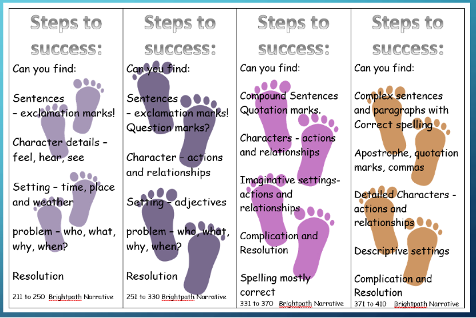Using Formative Assessments with Brightpath to Empower Students in Their Own Learning
Chrissy Marcelli, a Year 3/4 teacher at Southern Grove Primary School in Western Australia, joined our second Edchat session this week. She shared the fantastic strategies she’s developed to involve her students in the writing assessment process. Here is an overview of the resources Chrissy has developed from Brightpath Progress assessments.
Chrissy’s approach to formative assessments
Chrissy Marcelli has been a long-time user of Brightpath Progress and from the outset Chrissy greatly valued how Brightpath helped her teach writing more successfully.
From early on, Chrissy explored ways she could involve students in the formative assessment process so they would be more engaged and motivated in their own learning.
While in the past, colleagues used Brightpath posters to show students their learning progress, Chrissy aimed to share that progress without revealing their relative position to other students.
After experimenting with a few ideas, Chrissy settled on developing colourful footprints for her class.
Building student engagement with colourful footprints
Chrissy created a coloured footprint for each of the Brightpath performance descriptors and teaching points bands. She then adapted this concept for various resources. After assessing her students on the Brightpath scale, she informs the students of their scores and they can easily see what they’ve accomplished and what they are learning next.
Here is the card she developed for the narrative score range, 411 – 490. On the left, students can read what they can do, and on the right, they can see what they are learning to do.
Figure 1: Narrative cards created by Chrissy that students use to read, write, plan and set goal and reflect on their learning as they develop self-regulated learning strategies.
.png)
When Chrissy displays the footprints in her classroom, she deliberately ensures there is no particular order in which they are shown, so students focus on the footprint that relates to them, rather than comparing themselves to their friends.
This strategy has been successful, as Chrissy has found that her students get excited about the colour of the footprint they’re assessed on, and they eagerly discuss what they can do and what they are learning next.
“It’s a nice easy way of leveling, without them feeling that they are the lowest in the class.”
Another strategy Chrissy employs is to start with a level much lower than the student’s actual ability, discuss that level with them, and then boost their confidence by saying, “No, you are much better than this; let’s look at another footprint”.
As she works with students, she gives them the opportunity to reflect on their work and discuss what they believe their goals should be.
Building a common language through vocabulary
It’s important to note that Chrissy spends time teaching students the vocabulary and metalanguage used in the performance descriptors and teaching points. This includes teaching students terms such as conflict, resolution, narrative voice, adverbs and so on.
Explicitly teaching students the meanings of words and phrases allows them to access the information on the footprints and provides a common language for students to discuss their writing with both Chrissy and their peers.
One-on-one conferencing with formative assessments
Chrissy provides the footprints on A3 printouts to use when conferencing with students one-on-one.
She’s found this process allows for quick discussions, as students are familiar with the criteria and can readily evaluate their strengths and areas where they need to improve.
Student resources for enhanced learning
Chrissy has developed a set of cards for students to use as their own resource. She’s observed that students naturally turn to these resources as they write. She was also pleasantly surprised when students started using what they were learning about their own writing to analyse the books they were reading.
“It has led to wonderful inquiry questions about the choices authors make.”
Visualising student progress
Here’s the town Chrissy created to help students focus on their ‘next destination.’ Each student has their own pop-stick character which they place on the map according to their footprint. Chrissy noted that while students may not move to many of the places during the year, they remain excited about knowing where they are on the map.
Each time a student sets their goal, they’re encouraged to select only one or two areas to focus on so that their goals are achievable within a realistic time frame.
“It’s not only visible learning, it’s visible assessing.
Setting achievable formative assessment goals
Students regularly use bookmarks so they can access more simplified information about their success criteria. Chrissy has found that the bookmarks help students write their goals and stay on task. They also use the bookmarks to help them reflect on what they’ve achieved.
Figure 2: Narrative 211-410 bookmarks to help students write their goals and stay on task.

Chrissy’s recommendations for effective formative assessments
Chrissy recommends;
“Do it your way, do it in a range of creative ways, make sure it supports students learning needs”.
Consider how you can apply this approach in gradual release instruction, goal setting, collaborative learning, reflections, peer-editing and planning to support metacognition.
Watch Chrissy’s presentation here:
For more about Brightpath Progress request a demo here